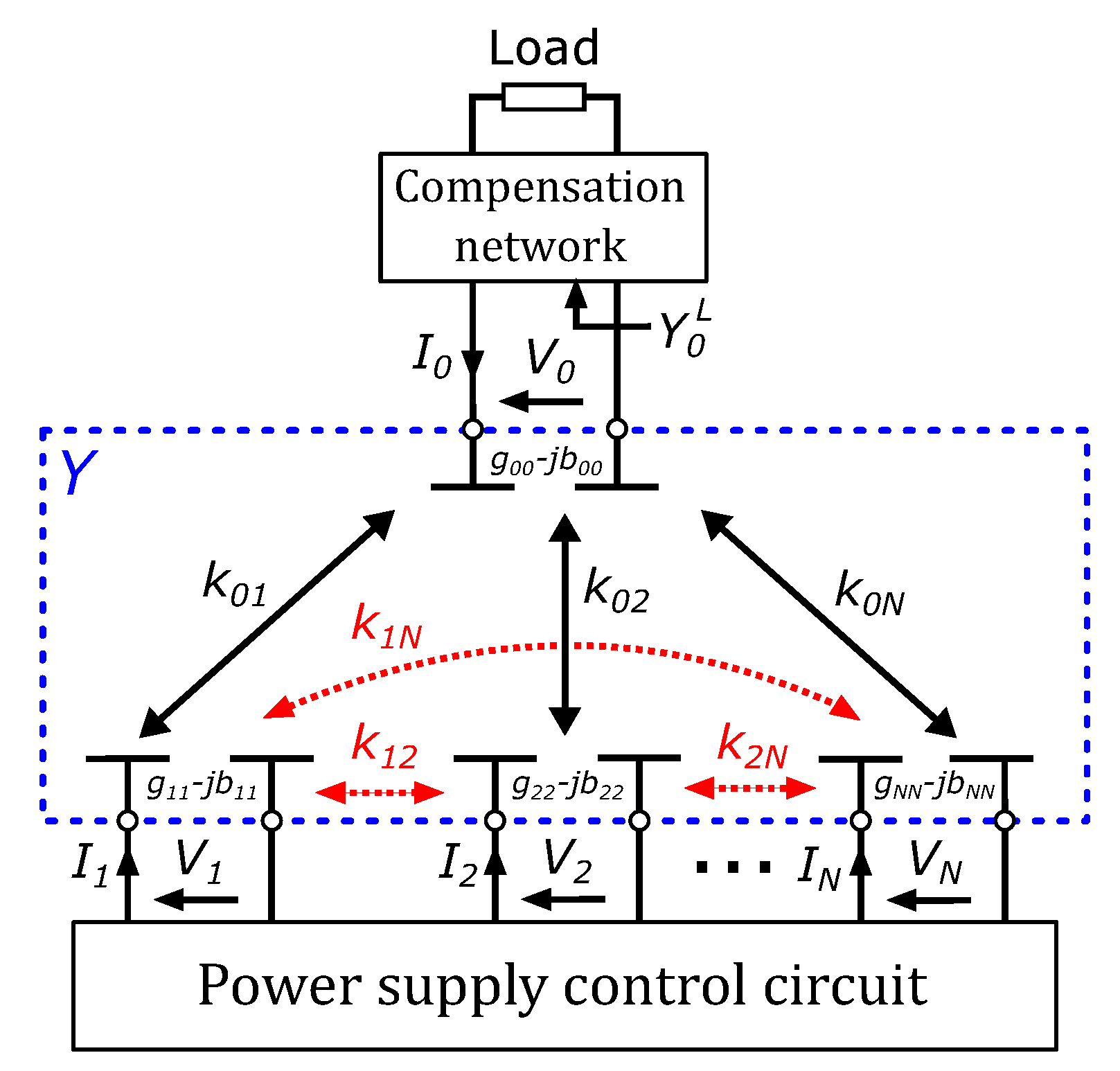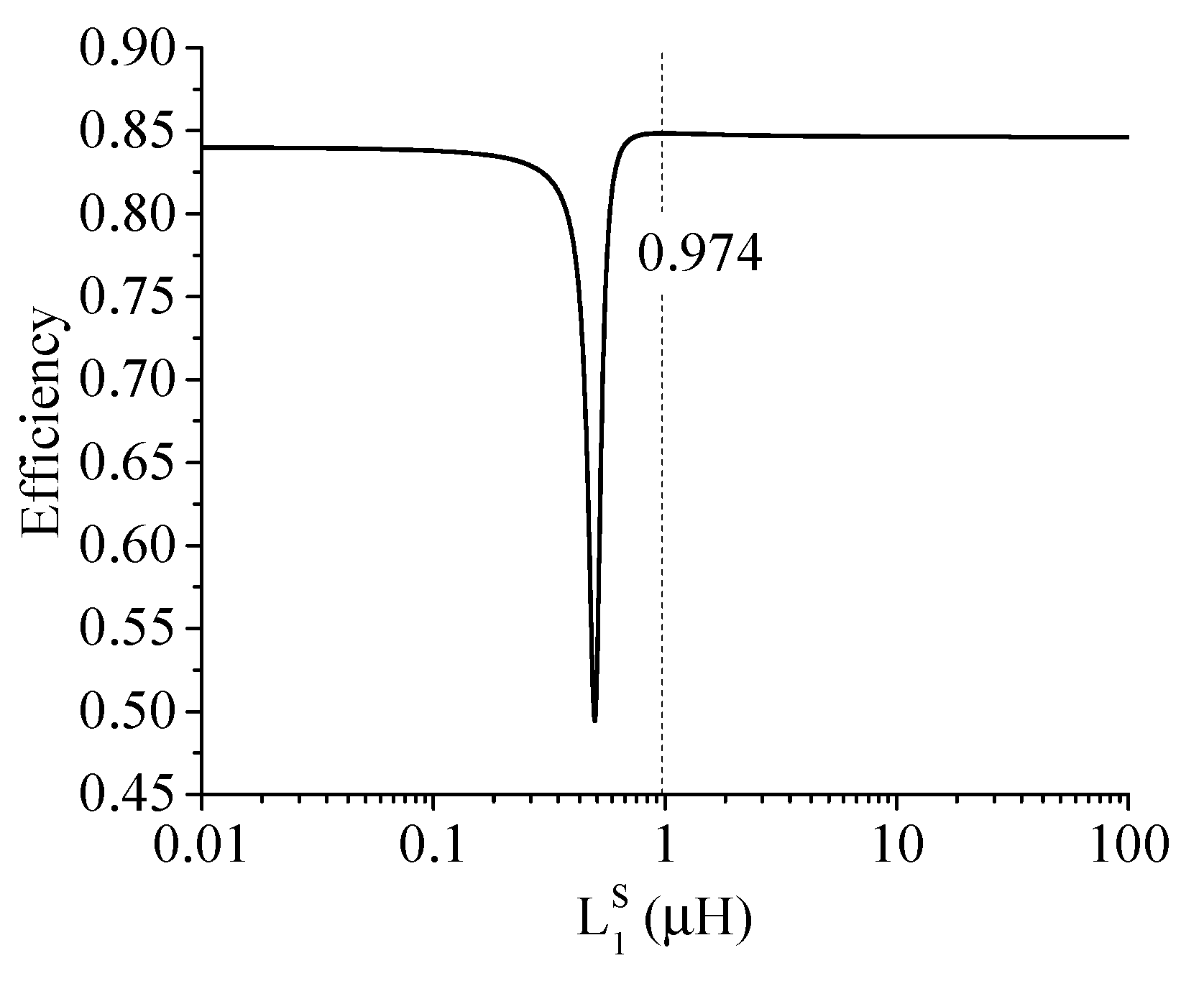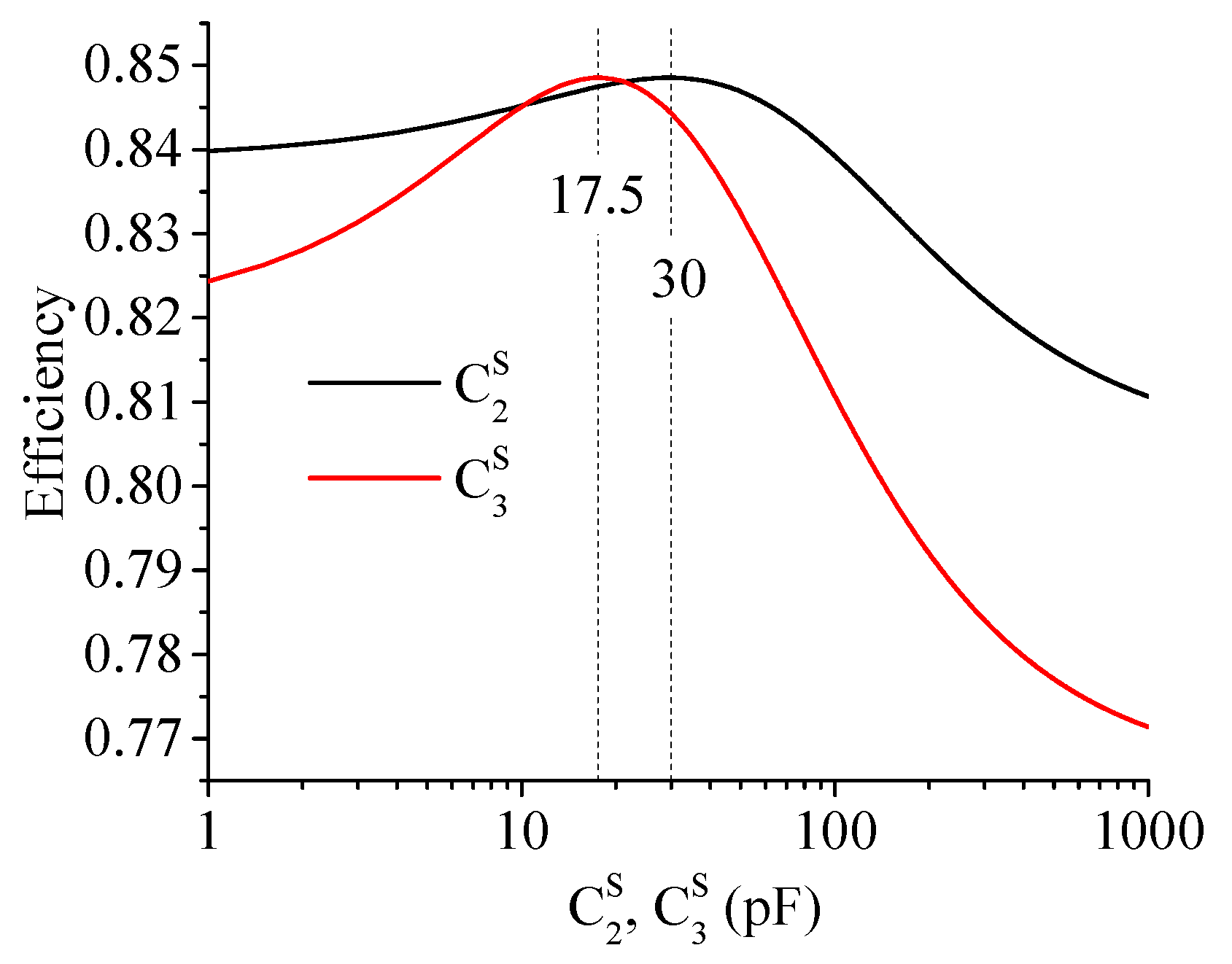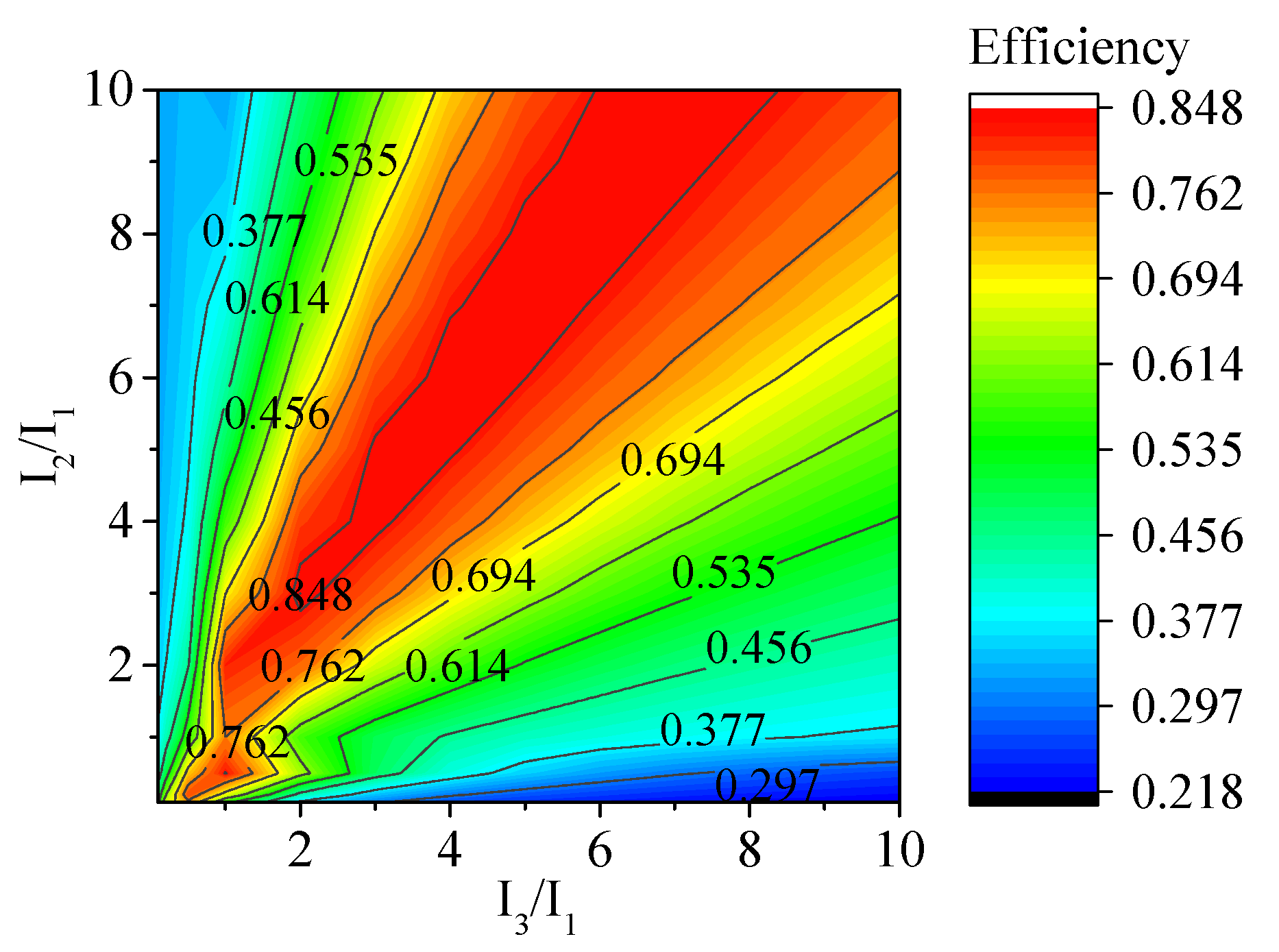Capacitive Wireless Power Transfer with Multiple Transmitters: Efficiency Optimization
Abstract
1. Introduction
- First, multiple transmitters targeting a single receiver results in a certain robustness against misalignment or mispositioning of the receiver. This extends the mobility of the receiver. If, for example, multiple transmitters are present in a planar configuration, the power transfer can be realized for a wide possibility of planar receiver positions.
- Second, the above implies that the use of multiple transmitters can extend the range of the wireless power transfer.
- A decentralization of the transmitters can possibly facilitate high-power energy transfer by applying multiple cheaper low-power input supplies.
- Multiple transmitters make the WPT system less vulnerable to foreign blocking objects.
- Last but not least, as will be shown in this work, multiple transmitters allow for a higher system efficiency for given coupling coefficients since they allow for a higher degree of freedom for the power input distribution.
- By matching the internal shunt admittance of the generators to the system, the maximum-efficiency solution coincides with the configuration that maximizes the output power (Section 4).
- It is shown that the cross-coupling between the transmitters does not influence the value of the maximum efficiency or optimal load: by including a reactive part at the transmitter side, the impact of cross-coupling can be neutralized. Moreover, the efficiency of the CPT system can be increased by adding extra transmitters (Section 5).
- It is demonstrated that the maximum efficiency of the multiple transmitter system can be estimated by measuring the individual transmitter–receiver links (Section 5).
- Finally, the analytical solution is demonstrated on an example equivalent circuit of a CPT system. The results are verified by numerical circuit simulation for a system with three transmitters and a single receiver (Section 6).
2. Problem Description
3. Power and Efficiency of the CPT System
3.1. Admittance Matrix
3.2. Input Power
3.3. Output Power
3.4. Efficiency
4. Maximum-Efficiency Solution
4.1. First-Order Necessary Condition
4.2. Optimal Input and Output Power
4.3. Maximum Efficiency
4.4. Optimal Input Voltages, Currents, and Admittances
4.5. Optimal Load Admittance
5. Discussion
6. Numerical Verification
7. Conclusions
Author Contributions
Funding
Acknowledgments
Conflicts of Interest
References
- Zhu, Q.; Zang, S.; Zou, L.J.; Zhang, G.; Su, M.; Hu, A.P. Study of coupling configurations of capacitive power transfer system with four metal plates. Wirel. Power Transf. 2019, 6, 97–112. [Google Scholar] [CrossRef]
- Wang, K.; Sanders, S. Contactless USB—A capacitive power and bidirectional data transfer system. In Proceedings of the IEEE Applied Power Electronics Conference and Exposition-APEC, Fort Worth, TX, USA, 16–20 March 2014; pp. 1342–1347. [Google Scholar]
- Hu, A.P.; Liu, C.; Li, H.L. A novel contactless battery charging system for soccer playing robot. In Proceedings of the IEEE 15th International Conference on Mechatronics and Machine Vision in Practice, Auckland, New Zealand, 2–4 December 2008; pp. 646–650. [Google Scholar]
- Culurciello, E.; Andreou, A.G. Capacitive inter-chip data and power transfer for 3-D VLSI. IEEE Trans. Circ. Syst. II Express Briefs 2006, 53, 1348–1352. [Google Scholar] [CrossRef]
- Mostafa, T.M.; Muharam, A.; Hattori, R. Wireless battery charging system for drones via capacitive power transfer. In Proceedings of the IEEE PELS Workshop on Emerging Technologies: Wireless Power Transfer (WoW), Chongqing, China, 20–22 May 2017; pp. 1–6. [Google Scholar]
- Sodagar, A.M.; Amiri, P. Capacitive coupling for power and data telemetry to implantable biomedical microsystems. In Proceedings of the IEEE 4th International IEEE/EMBS Conference on Neural Engineering, Antalya, Turkey, 29 April–2 May 2009; pp. 411–414. [Google Scholar]
- Jegadeesan, R.; Agarwal, K.; Guo, Y.X.; Yen, S.C.; Thakor, N.V. Wireless power delivery to flexible subcutaneous implants using capacitive coupling. IEEE Trans. Microw. Theory Tech. 2016, 65, 280–292. [Google Scholar] [CrossRef]
- Ramos, I.; Afridi, K.; Estrada, J.A.; Popović, Z. Near-field capacitive wireless power transfer array with external field cancellation. In Proceedings of the IEEE Wireless Power Transfer Conference (WPTC), Aveiro, Portugal, 5–6 May 2016; pp. 1–4. [Google Scholar]
- Miyazaki, M.; Abe, S.; Suzuki, Y.; Sakai, N.; Ohira, T.; Sugino, M. Sandwiched parallel plate capacitive coupler for wireless power transfer tolerant of electrode displacement. In Proceedings of the IEEE MTT-S International Conference on Microwaves for Intelligent Mobility (ICMIM), Nagoya, Japan, 19–21 March 2017; pp. 29–32. [Google Scholar]
- Dai, J.; Ludois, D.C. Wireless electric vehicle charging via capacitive power transfer through a conformal bumper. In Proceedings of the IEEE Applied Power Electronics Conference and Exposition (APEC), Charlotte, NC, USA, 15 March 2015; pp. 3307–3313. [Google Scholar]
- Sakai, N.; Itokazu, D.; Suzuki, Y.; Sakihara, S.; Ohira, T. One-kilowatt capacitive Power Transfer via wheels of a compact Electric Vehicle. In Proceedings of the IEEE Wireless Power Transfer Conference (WPTC), Aveiro, Portugal, 5–6 May 2016; pp. 1–3. [Google Scholar]
- Sinha, S.; Kumar, A.; Regensburger, B.; Afridi, K.K. A new design approach to mitigating the effect of parasitics in capacitive wireless power transfer systems for electric vehicle charging. IEEE Trans. Transp. Electr. 2019, 1040–1059. [Google Scholar] [CrossRef]
- Monti, G.; Che, W.; Wang, Q.; Costanzo, A.; Dionigi, M.; Mastri, F.; Mongiardo, M.; Perfetti, R.; Tarricone, L.; Chang, Y. Wireless power transfer with three-ports networks: Optimal analytical solutions. IEEE Trans. Circ. Syst. I Regul. Pap. 2016, 64, 494–503. [Google Scholar] [CrossRef]
- Ujihara, T.; Duong, Q.T.; Okada, M. kQ-product analysis of inductive power transfer system with two transmitters and two receivers. In Proceedings of the IEEE Wireless Power Transfer Conference, Taipei, Taiwan, 10–12 May 2017. [Google Scholar]
- Duong, Q.T.; Okada, M. kQ-product formula for multiple-transmitter inductive power transfer system. IEICE Electron. Express 2017, 14, 20161167. [Google Scholar] [CrossRef]
- Arakawa, T.; Goguri, S.; Krogmeier, J.V.; Kruger, A.; Love, D.J.; Mudumbai, R.; Swabey, M.A. Optimizing wireless power transfer from multiple transmit coils. IEEE Access. 2018, 6, 23828–23838. [Google Scholar] [CrossRef]
- Lang, H.D.; Sarris, C.D. Semidefinite relaxation-based optimization of multiple-input wireless power transfer systems. IEEE Trans. Microw. Theory Tech. 2017, 65, 4294–4306. [Google Scholar] [CrossRef]
- Lang, H.D.; Ludwig, A.; Sarris, C.D. Convex optimization of wireless power transfer systems with multiple transmitters. IEEE Trans. Antennas Propagat. 2014, 62, 4623–4636. [Google Scholar] [CrossRef]
- Monti, G.; Wang, Q.; Che, W.; Costanzo, A.; Mastri, F.; Mongiardo, M. Maximum wireless power transfer for multiple transmitters and receivers. In Proceedings of the IEEE MTT-S International Conference on Numerical Electromagnetic and Multiphysics Modeling and Optimization (NEMO), Beijing, China, 27–29 July 2016; pp. 1–3. [Google Scholar]
- Duong, Q.T.; Okada, M. Maximum efficiency formulation for inductive power transfer with multiple receivers. IEICE Electron. Express 2016, 13, 20160915. [Google Scholar] [CrossRef][Green Version]
- Yoon, I.J.; Ling, H. Investigation of near-field wireless power transfer under multiple transmitters. IEEE Antennas Wirel. Propag. Lett. 2011, 10, 662–665. [Google Scholar] [CrossRef]
- Minnaert, B.; Stevens, N. Optimal analytical solution for a capacitive wireless power transfer system with one transmitter and two receivers. Energies 2017, 10, 1444. [Google Scholar] [CrossRef]
- Minnaert, B.; Mongiardo, M.; Costanzo, A.; Mastri, F. Maximum Efficiency Solution for Capacitive Wireless Power Transfer with N Receivers. Wirel. Power Transf. 2020, 1–11. [Google Scholar] [CrossRef]
- Huang, L.; Hu, A.P. Defining the mutual coupling of capacitive power transfer for wireless power transfer. Electron. Lett. 2015, 51, 1806–1807. [Google Scholar] [CrossRef]
- Hong, J.S.G.; Lancaster, M.J. Microstrip Filters for RF/Microwave Applications, 1st ed.; John Wiley & Sons: New York, NY, USA, 2001; pp. 235–253. [Google Scholar]
- Boyd, S.; Vandenberghe, L. Convex Optimization, 2nd ed.; Cambridge University Press: Cambridge, UK, 2004; p. 140. [Google Scholar]
- Ohira, T. Extended k-Q product formulas for capacitive-and inductive-coupling wireless power transfer schemes. IEICE Electron. Express 2014, 11, 20140147. [Google Scholar] [CrossRef]
- Minnaert, B.; Stevens, N. Single variable expressions for the efficiency of a reciprocal power transfer system. Int. J. Circ. Theory Appl. 2017, 10, 1418–1430. [Google Scholar] [CrossRef]
- Sugiyama, R.; Duong, Q.T.; Okada, M. kQ-product analysis of multiple-receiver inductive power transfer with cross-coupling. In Proceedings of the International Workshop on Antenna Technology: Small Antennas, Innovative Structures, and Applications (iWAT), Athens, Greece, 1–3 March 2017. [Google Scholar]
- Dionigi, M.; Mongiardo, M.; Monti, G.; Perfetti, R. Modelling of wireless power transfer links based on capacitive coupling. Int. J. Numer. Model. Electron. Netw. Dev. Fields 2017, 30, e2187. [Google Scholar] [CrossRef]
- Kracek, J.; Svanda, M. Analysis of Capacitive Wireless Power Transfer. IEEE Access. 2018, 7, 26678–26683. [Google Scholar] [CrossRef]
- Kim, D.H.; Ahn, D. Optimization of Capacitive Wireless Power Transfer System for Maximum Efficiency. J. Electr. Eng. Technol. 2020, 15, 343–352. [Google Scholar] [CrossRef]









| Quantity | Value | Quantity | Value |
|---|---|---|---|
| 10.0 MHz | 100 mA | ||
| 1.00 mS | 350 pF | ||
| 1.00 mS | 350 pF | ||
| 1.50 mS | 300 pF | ||
| 0.50 mS | 275 pF | ||
| 500 pF | 500 pF |
| Desired Couplings | Value | Undesired Couplings | Value |
|---|---|---|---|
| 14.3% | 6.2% | ||
| 46.3% | 16.1% | ||
| 32.2% | 3.5% |
| Quantity | Value | Quantity | Value |
|---|---|---|---|
| 724 nH | 3.1 | ||
| 724 nH | 7.7 | ||
| 844 nH | 8.9 | ||
| 921 nH | 12.2 |
| Quantity | Value | Quantity | Value |
|---|---|---|---|
| 300 mA | 200 mA | ||
| () | 12.2 mS (81.9 ) | 974 nH | |
| 506 nH | 30.0 pF | ||
| 84.9% | 17.5 pF |
© 2020 by the authors. Licensee MDPI, Basel, Switzerland. This article is an open access article distributed under the terms and conditions of the Creative Commons Attribution (CC BY) license (http://creativecommons.org/licenses/by/4.0/).
Share and Cite
Minnaert, B.; Costanzo, A.; Monti, G.; Mongiardo, M. Capacitive Wireless Power Transfer with Multiple Transmitters: Efficiency Optimization. Energies 2020, 13, 3482. https://doi.org/10.3390/en13133482
Minnaert B, Costanzo A, Monti G, Mongiardo M. Capacitive Wireless Power Transfer with Multiple Transmitters: Efficiency Optimization. Energies. 2020; 13(13):3482. https://doi.org/10.3390/en13133482
Chicago/Turabian StyleMinnaert, Ben, Alessandra Costanzo, Giuseppina Monti, and Mauro Mongiardo. 2020. "Capacitive Wireless Power Transfer with Multiple Transmitters: Efficiency Optimization" Energies 13, no. 13: 3482. https://doi.org/10.3390/en13133482
APA StyleMinnaert, B., Costanzo, A., Monti, G., & Mongiardo, M. (2020). Capacitive Wireless Power Transfer with Multiple Transmitters: Efficiency Optimization. Energies, 13(13), 3482. https://doi.org/10.3390/en13133482








